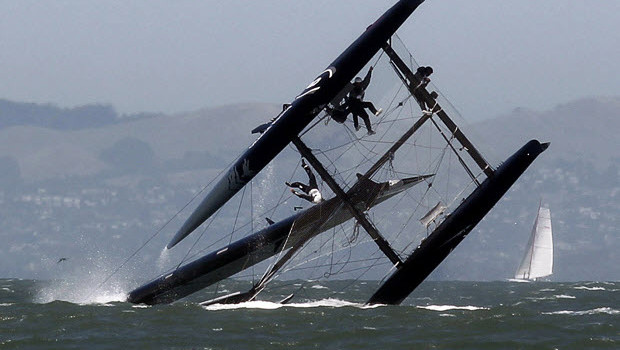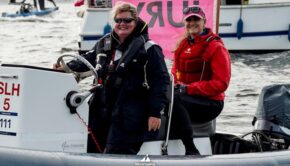Trouble at the Top of the Sport
Published on December 4th, 2015
After it was announced on December 2 that the Chief Executive Officer of the International Sailing Federation, Peter Sowrey, had resigned after just five months on the job, Rob Kothe of Sail-World wasn’t all that surprised. Here he reports…
In October 2014 Sail-World was in Palma, Mallorca to watch and listen the deliberations of the International Sailing Federation (ISAF), the world governing body for the sport of sailing. Annual General Meeting council.
We were frankly appalled at the time management of the critical last two days of the event, of the major meeting when the Council met and deliberated on a large number of submissions from MNAs around the world.
It was easy to see why the group could have made the kind of stupid decision making errors that will go down in history such as the famous removal of the Tornado multihull from the 2012 Olympics.
For the last two years Sail-World has been attempting to find a copy of the overall plan. The master plan. The core mission statement of ISAF – without success. (Does anyone have a copy they can forward to us?).
We’ve asked numbers of people in ISAF. They say they will get back to us, but all we hear is the sound of crickets.
It is therefore not surprising that the delegates and the MNA’s could produce submissions which in fact may have gone in the opposite direction to the unpublished philosophy and aims of the organisation.
Just as the decision to cut the Tornado, for purely political reasons, went in the opposite direction to the ISAF submission to the IOC which had said our aim is to have faster, more exciting boats. That historic vote removed the fastest and most exciting boat from the Olympic suite.
At the 2014 AGM, there was a lot of work to be done and very important decisions to be made and then what struck us was the amount of time that was nothing more than entertainment and the background education for an expensively assembled group.
We estimate that at least a third of the time of the last critical two days’ critical decision making of the meeting was spent on education, running of videos, briefing speeches etc.
All this information could have been presented to the delegates on a DVD two or three weeks prior to the event, letting people spend five or six hours of their time watching this content.
That would have allowed them to come to the Council meeting up to speed and ready to engage in constructive debate and informed decision making.
Large numbers of submissions were put to the council with no cross reference between the any unpublished overall council policy and the direction of the actual submission.
With precious time already consumed, the deliberations of the group, was cut short because of a crammed list of items, many of them nonsensical that required formal decisions.
There were in fact rare glimpses of actual intelligent debate and conversation amongst the delegates.
The whole event was deeply depressing.
After the weekend I commented to one of the ISAF old hands among the delegates, how appalling the time management and decision making had been at the meeting and he said to me, ‘I guess that was your first ISAF AGM meeting? ‘I nodded and he said ‘I thought so. ‘It was so much better than in the olden days!!’
The reality is that had that procedure been followed in a commercial environment heads would have rolled.
 This was the environment that still existed in early July 2015 when Sail-World interviewed, on his very first day in the office, Peter Sowrey the man in the hot seat in Southampton.
This was the environment that still existed in early July 2015 when Sail-World interviewed, on his very first day in the office, Peter Sowrey the man in the hot seat in Southampton.
Sowrey had a strong corporate background in large organisations where decision making was a premium and this decision making was fact based.
At the time we asked Sowrey just how he felt he could handle the politics of a very political organisation ISAF. He said,’ I am not interested in politics, I let the facts speak for themselves’.
Sowrey’s optimism on his ability to engender change within the pea sailing body without worrying about politics seemed to us overly optimistic and so it is proven.
Now the highly credentialed and experienced corporate reformer is gone.
Did he jump or was he pushed?
Although he was an enthusiastic sailor he had not been involved in the machinations of ISAF and not been present at any ISAF Annual Conferences or Mid-Year conferences.
Looking at the background of the conversation that came out of Sanya, China, at the Annual General Meeting, that is pretty plain to see. The speed at which the CEO wanted to move and the speed at the which the ISAF executive has traditionally moved seem to be poles apart.
One commentator said to us upon hearing of Sowrey’s departure is that perhaps the problem is that our representatives at ISAF are displeased with interruptions when they are drinking champagne and they certainly don’t like their opinions being questioned.
The previous CEO Jerome Pels had been in the organisation for some years before he took on the CEO role and it’s clear given the sorry state of the organisation he left after 17 years, sadly it seems he did not rock the boat.
Going forward it would appear that the selection of a new CEO for ISAF is going to be even more difficult if the most recent CEO found that his position was unacceptable after less than six months.
Now it seems ISAF is unlikely to appoint a reformist CEO going forward. Probably one won’t present anyway, as where now do you find a reformer out there who believes he can find his way through the ISAF politics.
Regardless, when the ISAF Executive next sits down together, one hopes they don’t smugly congratulate each other for seeing off someone who was questioning their lack of direction and leadership, but rather hang their heads in shame at failing to rise to the reformist challenge.
Which do you think they will do?









 We’ll keep your information safe.
We’ll keep your information safe.